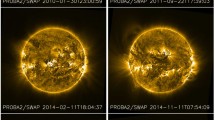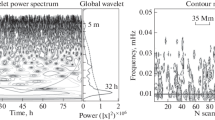Abstract
We investigate the evolutionary effects on the brightness of a sunspot as well as on the properties of its fine-structures using two sets of time series of G-band images of a single sunspot in NOAA 10944 recorded at two symmetric locations on the solar disc by Hinode/SOT (Solar Optical Telescope). The second time series (phase W) was recorded 2.5 d after recording the first time series (phase E). Both time series of images were corrected for instrumental stray light; then the p-mode oscillations were removed. Our analysis demonstrates that the spatially and temporally averaged intensities of the umbra as well as the penumbra in both phases are practically the same. Nevertheless, considering only intensities smaller than 1.0\(\mbox{I}_{\mathrm{ph}}\) the penumbra in the phase W is brighter with a contrast of 2 per cent. However, the ratio of the peak intensities of penumbral grains to their background intensities decreases, on average, from 2.9 to 2.6 from phase E to phase W. The penumbra is on average, 6.9 times brighter than the umbra in both phases. The umbra gets smaller in size with a ratio of 0.90 and its magnetic field strength decreases about 200 G after the 2.5 d evolution. Although the central umbral dots (UDs) with lifetimes longer than 2 min are by the factor of 1.6 more frequent in phase E, the most of the physical and kinematic properties of UDs do not show considerable changes after the sunspot evolution at this 2.5 d time interval. The registered UDs have intensities smaller than 0.84\(\mbox{I}_{\mathrm{ph}}\) with a mean intensity of about 0.29\(\mbox{I}_{\mathrm{ph}}\). The equivalent diameters of the individual UDs have a symmetric distribution around 180 km with a standard deviation about 35 km. The brightest UDs show a constant median diameter. The UDs registered in both phases have a mean lifetime of 7.4 min. Our results suggest that UDs with a certain lifetime have an admissible lower limit for their mean size which grows with lifetime. The proper motions of UDs show velocities less than \(1.0~\mbox{km}\,\mbox{s}^{-1}\) with a maximum population around \(0.2~\mbox{km}\,\mbox{s}^{-1}\). The UDs formed in the phase W are faster when the umbral area is smaller and the magnetic field is weaker.








Similar content being viewed by others
Notes
Contrast: the “difference” divided by the “average”: \(\mbox{contrast}=2(I_{2}-I_{1})/(I_{2}+I_{1})\).
References
Bharti, L., Beeck, B., Schüssler, M.: 2010, Astron. Astrophys.510, 12. DOI .
Bovelet, B., Wiehr, E.: 2001, Solar Phys.201, 13. DOI .
Bray, R.J., Loughhead, R.E.: 1964, Sunspots, Chapman and Hall, London.
Domingo, V., Fleck, B., Poland, A.I.: 1995, Solar Phys.162, 1. DOI .
Hamedivafa, H.: 2008, Solar Phys.250, 17. DOI .
Hamedivafa, H.: 2011, Solar Phys.270, 75. DOI .
Kiess, C., Rezaei, R., Schmidt, W.: 2014, Astron. Astrophys.565, 52. DOI .
Kilcik, A., Yurchyshyn, V.B., Rempel, M., et al.: 2012, Astrophys. J.745, 163. DOI .
Kitai, R., Watanabe, H., Nakamura, T., et al.: 2007, Publ. Astron. Soc. Japan59, 585. DOI .
Kopp, G., Rabin, D.: 1992, Solar Phys.141, 253. DOI .
Louis, R.E., Mathew, S.K., Bellot Rubio, L.R., et al.: 2012, Astrophys. J.752, 109. DOI .
Martínez Pillet, V., Vázquez, M.: 1993, Astron. Astrophys.270, 494.
Mathew, S.K., Zakharov, V., Solanki, S.K.: 2009, Astron. Astrophys.501, 19. DOI .
Mathew, S.K., Martínez Pillet, V., Solanki, S.K., Krivova, N.A., et al.: 2007, Astron. Astrophys.465, 291. DOI .
Molowny-Horas, R.: 1994, Solar Phys.154, 29. DOI .
Norton, A.A., Gilman, P.A.: 2004, Astrophys. J.603, 348. DOI .
Rezaei, R., Beck, C., Schmidt, W.: 2012, Astron. Astrophys.541, 60. DOI .
Riethmüller, T.L., Solanki, S.K., Zakharov, V., Gandorfer, A.: 2008, Astron. Astrophys.492, 233. DOI .
Schad, T.A., Penn, M.J.: 2010, Solar Phys.262, 19. DOI .
Schlichenmaier, R., von der Lühe, O., Hoch, S., et al.: 2016, Astron. Astrophys.596, 7. DOI .
Schüssler, M., Vögler, A.: 2006, Astrophys. J.641, L73. DOI .
Sobotka, M., Bonet, J.A., Vázquez, M.: 1993, Astrophys. J.415, 832. DOI .
Sobotka, M., Brandt, P.N., Simon, G.: 1997a, Astron. Astrophys.328, 682.
Sobotka, M., Brandt, P.N., Simon, G.: 1997b, Astron. Astrophys.328, 689.
Sobotka, M., Hanslmeier, A.: 2005, Astron. Astrophys.442, 323. DOI .
Sobotka, M., Puschamnn, K.G.: 2009, Astron. Astrophys.504, 575. DOI .
Sobotka, M., Rezaei, R.: 2017, Solar Phys.292, 188. DOI .
Sobotka, M., Váquez, M., Bonet, J.A., et al.: 1999, Astrophys. J.511, 436. DOI .
Solanki, S.K.: 2003, Sunspots: an overview. Astron. Astrophys. Rev.11, 153. DOI .
Strous, L.H.: 1994, Ph.D. thesis, Utrecht University.
Tritschler, A., Schmidt, W.: 2002, Astron. Astrophys.388, 1048. DOI .
Tsuneta, S., Ichimoto, K., Katsukawa, Y., et al.: 2008, Solar Phys.249, 167. DOI .
Watanabe, H.: 2014, Publ. Astron. Soc. Japan66, 1. DOI .
Watanabe, H., Kitai, R., Ichimoto, K.: 2009, Astrophys. J.702, 1048. DOI .
Yadav, R., Louis, R.E., Mathew, S.K.: 2018, Astrophys. J.855, 8. DOI .
Zwaan, C.: 1968, Annu. Rev. Astron. Astrophys.6, 135. DOI .
Acknowledgements
Hinode is a Japanese mission developed and launched by ISAS/JAXA, with NAOJ as domestic partner and NASA and UKSA as international partners. It is operated by these agencies in co-operation with ESA and NSC (Norway). The data reduction and some parts of the data analysis of this work was carried out on the Multi-wavelength Data Analysis System (MDAS) operated by the Astronomy Data Center (ADC), National Astronomical Observatory of Japan (NAOJ). The author sincerely thanks Prof. Kiyoshi Ichimoto for his supports. The author also thanks the referee for all constructive suggestions that improved the paper.
Author information
Authors and Affiliations
Corresponding author
Ethics declarations
Disclosure of Potential Conflicts of Interest
The author declares that there are no conflicts of interest.
Additional information
Publisher’s Note
Springer Nature remains neutral with regard to jurisdictional claims in published maps and institutional affiliations.
Rights and permissions
About this article
Cite this article
Hamedivafa, H. Comparative Study of a Sunspot at Two Different Instances of Time. Sol Phys 295, 60 (2020). https://doi.org/10.1007/s11207-020-01627-x
Received:
Accepted:
Published:
DOI: https://doi.org/10.1007/s11207-020-01627-x




